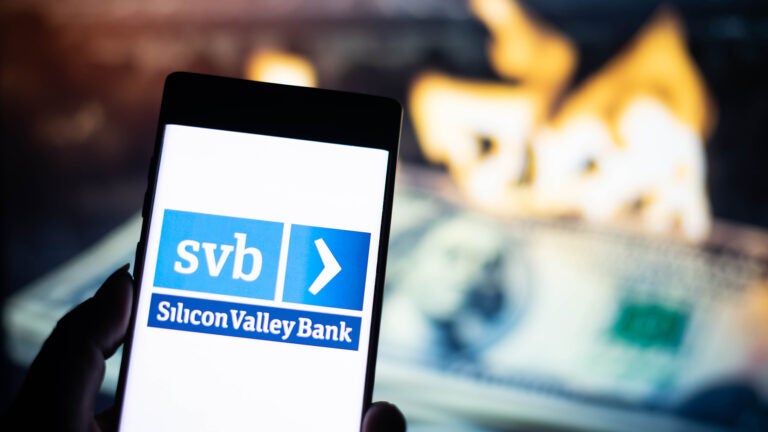
Silicon Valley Bank was the 16th-largest bank in the country before its collapse. (Photo/AdobeStock)
Too big to fail, too small to regulate: Silicon Valley Bank — and others
USC experts discuss the systemic issues plaguing the U.S. banking system and the regulatory gaps exposed by the financial collapse of Silicon Valley Bank and other institutions.
Pandemonium broke loose in the banking world when Silicon Valley Bank collapsed earlier this month and sparked a chain reaction of similar failures, including Credit Suisse, First Republic Bank, Signature Bank, Silvergate Bank and others. Hundreds of banks remain at risk of the same fate.
USC experts in business and finance gave a postmortem account of the second-largest bank failure in U.S. history and the perfect storm of factors that led to Silicon Valley Bank’s demise.
With over $211 billion in assets by the end of 2022, SVB was the 16th-largest bank in the country before its collapse and a go-to funding source for venture capital-backed startups. A favorite among technology and health care companies, the bank catered to many of the high-risk, high-reward startups that had enjoyed a boom in profits during the pandemic.
Much of this influx of cash came to the bank in the form of uninsured deposits — amounts greater than the FDIC’s $250,000 limit to insure. In the event of a bank collapse, anything exceeding that amount is lost.
Banks are just supposed to work.
Paul Orlando, Lloyd Greif Center for Entrepreneurial Studies
“You can’t ask startups — at least the small ones — to be able to handle diligence on an institution as complicated as a bank. Banks are just supposed to work,” said Paul Orlando, director of the USC Incubator Program and an adjunct professor for the Lloyd Greif Center for Entrepreneurial Studies at the USC Marshall School of Business.
“Startups should be focused on how to serve their customers, build their teams and improve their product. Not needing to worry that your bank will collapse is a positive — and at least in the U.S., it’s assumed not to be worth worrying about.”
Silicon Valley Bank: A classic bank run
When Silicon Valley Bank released a midquarter update describing its strategic plan to shore up its finances after selling its securities portfolio at a loss, investors were quick to jump ship.
“Controlling the narrative has become a whole lot more challenging in the internet age,” said Kristen Jaconi, an expert in risk management and an associate professor of the practice of accounting at USC Marshall. “Depositors, spurred on by ominous emails, texts and social media posts, and the ease of mobile banking, attempted to withdraw $42 billion. SVB was no longer in control of the narrative. Fear was, as is typical for all liquidity runs.”
Most consumers understand little about the nuances of the banking system and don’t see much difference across the various banks, making for weak brand loyalty, experts explained.
“Consumers perceive the money in their account as ‘their’ money; they own it, it belongs to them and they believe that they should be able to take it out of the bank whenever they want,” said Valerie Folkes, an expert in consumer behavior and professor emeritus of marketing at USC Marshall.
(Story continues below video)
“People hate to lose money. If a consumer sees other consumers queuing up to remove funds, this apparent social consensus merely substantiates their own fears. Assurances about insured funds mean little to the customer.”
Dodd-Frank Act rollbacks, gross mismanagement laid the groundwork for financial ruin
According to Rodney Ramcharan, a professor of finance and business economics at USC Marshall, seeds of the crisis began with the 2018 rollback of the Dodd-Frank Act, which was originally aimed at increasing consumer protections after the Great Recession of 2007-2009.
“Had some of these financial regulations been in place, SVB would not have been allowed to use so many uninsured deposits to fund its activities. But in our democracy where money shapes politics, banks like SVB were able to persuade Congress and the Trump administration to roll back these rules,” Ramcharan said.
“With Dodd-Frank eviscerated, SVB and other smaller banks quickly expanded amid an environment of low interest rates. They borrowed cheaply and invested in higher-yielding long-term bonds. They took on a lot of risk, and once rates rose, that risk came home to roost.”
But Dodd-Frank rollbacks were just the beginning, experts said. Mismanagement and poor investment decisions by profit-hungry executives also played a critical role in the downfall of Silicon Valley Bank and the other midsized banks that continue to make headlines.
It’s like a pilot failing to check on the plane’s altitude or fuel and calling for help only after it’s too late to land safely.
Sanjay Sharma, USC Marshall
“It’s like a pilot failing to check on the plane’s altitude or fuel and calling for help only after it’s too late to land safely,” said Sanjay Sharma, an adjunct professor of finance and business economics at USC Marshall.
“SVB had no chief risk officer for eight months last year — during the critical period of increasing inflation, heightened geopolitical risk, crisis in crypto and a tech valuation meltdown. SVB’s examiners and supervisors should have been aware of these factors and instructed the bank to take measures to address its risks.”
Regulators were equally complicit by turning a blind eye to the bank’s dubious activities, Sharma said. But after the string of bank failures, more of which may still be on the horizon, regulators are playing catch-up.
“At first glance, this will result in a knee-jerk reaction by imposing new regulatory standards, and one hopes that it will not result in friction in sustaining and perpetuating economic growth while curtailing inflationary pressures.”



